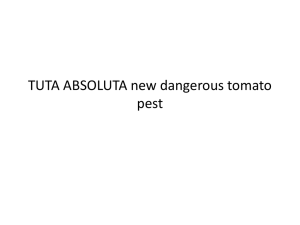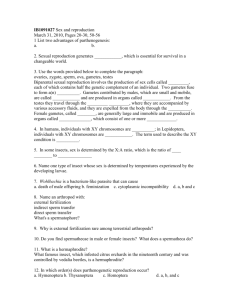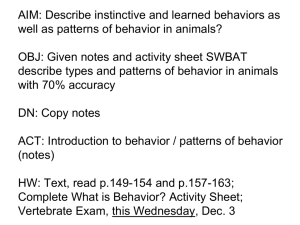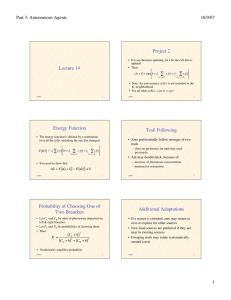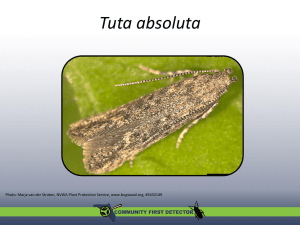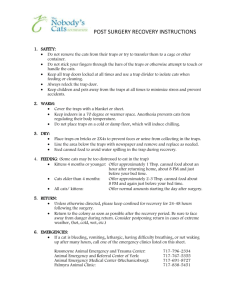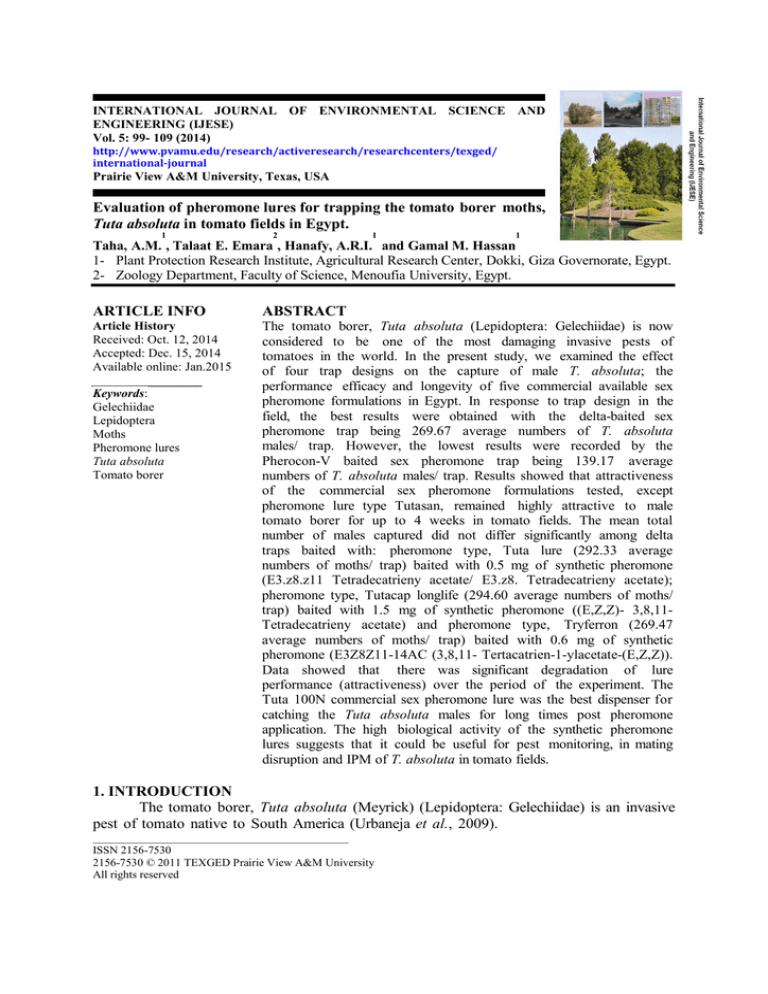
INTERNATIONAL JOURNAL OF ENVIRONMENTAL SCIENCE AND
ENGINEERING (IJESE)
Vol. 5: 99- 109 (2014)
http://www.pvamu.edu/research/activeresearch/researchcenters/texged/
international-journal
Prairie View A&M University, Texas, USA
Evaluation of pheromone lures for trapping the tomato borer moths,
Tuta absoluta in tomato fields in Egypt.
1
2
1
1
Taha, A.M. , Talaat E. Emara , Hanafy, A.R.I. and Gamal M. Hassan
1- Plant Protection Research Institute, Agricultural Research Center, Dokki, Giza Governorate, Egypt.
2- Zoology Department, Faculty of Science, Menoufia University, Egypt.
ARTICLE INFO
ABSTRACT
Article History
Received: Oct. 12, 2014
Accepted: Dec. 15, 2014
Available online: Jan.2015
_________________
Keywords:
Gelechiidae
Lepidoptera
Moths
Pheromone lures
Tuta absoluta
Tomato borer
The tomato borer, Tuta absoluta (Lepidoptera: Gelechiidae) is now
considered to be one of the most damaging invasive pests of
tomatoes in the world. In the present study, we examined the effect
of four trap designs on the capture of male T. absoluta; the
performance efficacy and longevity of five commercial available sex
pheromone formulations in Egypt. In response to trap design in the
field, the best results were obtained with the delta-baited sex
pheromone trap being 269.67 average numbers of T. absoluta
males/ trap. However, the lowest results were recorded by the
Pherocon-V baited sex pheromone trap being 139.17 average
numbers of T. absoluta males/ trap. Results showed that attractiveness
of the commercial sex pheromone formulations tested, except
pheromone lure type Tutasan, remained highly attractive to male
tomato borer for up to 4 weeks in tomato fields. The mean total
number of males captured did not differ significantly among delta
traps baited with: pheromone type, Tuta lure (292.33 average
numbers of moths/ trap) baited with 0.5 mg of synthetic pheromone
(E3.z8.z11 Tetradecatrieny acetate/ E3.z8. Tetradecatrieny acetate);
pheromone type, Tutacap longlife (294.60 average numbers of moths/
trap) baited with 1.5 mg of synthetic pheromone ((E,Z,Z)- 3,8,11Tetradecatrieny acetate) and pheromone type, Tryferron (269.47
average numbers of moths/ trap) baited with 0.6 mg of synthetic
pheromone (E3Z8Z11-14AC (3,8,11- Tertacatrien-1-ylacetate-(E,Z,Z)).
Data showed that there was significant degradation of lure
performance (attractiveness) over the period of the experiment. The
Tuta 100N commercial sex pheromone lure was the best dispenser for
catching the Tuta absoluta males for long times post pheromone
application. The high biological activity of the synthetic pheromone
lures suggests that it could be useful for pest monitoring, in mating
disruption and IPM of T. absoluta in tomato fields.
1. INTRODUCTION
The tomato borer, Tuta absoluta (Meyrick) (Lepidoptera: Gelechiidae) is an invasive
pest of tomato native to South America (Urbaneja et al., 2009).
____________________________________________
ISSN 2156-7530
2156-7530 © 2011 TEXGED Prairie View A&M University
All rights reserved
In 2009, it was detected in Marsa
Matrouh Governorate near the border of
Libya and subsequently spread rapidly in
all Egyptian Governorates with variable
levels (Temerak, 2011). Since the initial
detection, the pest caused serious damage
to tomato in invaded areas (Mohamed,
2011), and it is currently considered a key
agricultural threat to tomato production.
The caterpillars of this species feed on the
leaf mesophyll and also damage tomato
flowers, fruit and stems. The tomato borer
major sex pheromone components have
been identified as (3E, 8Z, 11Z) -3, 8,
11- tetradecatrien-1-yl acetate (E3 Z8 Z1114 Ac) (Attygalle et al., 1995). In addition
to the major component, a miner
constituent (<10 of volatile material) was
identified as (3E, 8Z)- 3,8- tetradecadien1-yl acetate (3E,8Z-14 Ac)(Griepink et al.,
1996 ; Fihlo et al., 2000). Zalom et al.
(2008) used pherocon 1-C traps in
monitoring surveys for the tomato pinworm,
Keiferia lycopersicella. Pherocon 1-C
traps operate similarly to delta traps. The
efficacy of 6 commercial pheromone traps
(Biagro, Opennatur, Trece, Trece 178,
Susbin and Trece 179) in trapping T.
absoluta were measured by Alfaro et al.
(2009) over 14 weeks in Spain. They
determined the pheromone load of the traps
and the lifetime of the trap emissions. The
initial pheromone load of the first 3 traps
was 318.2, 419.9 and 535.5 μg,
respectively. While those of the last 3 traps
listed above were 1615.5, 1886.6 and
2850.9 μg, respectively. From week 10,
the most effective trap was Opennatur,
which suggested that trap lifetime was 6-9
weeks. Trece 179 was the only trap that
maintained emission up to 14 weeks. The
efficacy of five trap designs was evaluated
by Ferrara et al. (2001) using 1 μg of the
synthetic major component (3E, 8Z, 11Z)3,8,11-tetradecatrienyl acetate (TDTA) of
the sex pheromone emitted by T. absoluta
females. They found that the synthetic
major component was highly attractive to
conspecific males. Bavaresco et al. (2005)
evaluated the seasonal fluctuation of the
tomato leaf worm, T. absoluta adults using
pheromone lures baited in delta traps in
Brazil. In Venezuela, Salas (2004 and 2007)
studied the capture of T. absoluta in traps
baited with its sex pheromone ((3E, 8Z,
11Z) -3, 8, 11-tetradecatrienyl acetate
(95%) + (3E, 8Z)-3,8- tetradecadienyl
acetate (5%)), dispensed in rubber septa in
experimental tomato plots, using water
traps and delta sticky traps. He showed that
water trap had a greater number of captures
with differences compared to delta sticky
trap.
The tomato borer synthetic sex
pheromone has been efficiently used for
monitoring (Harizanova et al., 2009;
Braham, 2014), mass trapping (Taha et al.,
2013), and mating disruption (Fihlo et al.,
2000). Efficiency of pheromone baited
traps or matting disruption could be
affected by many factors, such as trap
design,
pheromone
composition,
pheromone dispenser, duration of lures and
climate, etc. (Carde' and Minks, 1995;
Reddy and Urs, 1996; Môttus et al., 1997).
Since the tomato borer is a serious pest in
tomato fields, the above mentioned factors
should be considered in designing a good
trap to capture the males. Therefore, the
objectives of this study were: i) to
determine the effect of four trap designs
on the capture of male T. absoluta; ii) to
compare the performance of five marks of
the most used sex pheromone capsules in
Egypt and iii) to compare efficacy and
longevity of five commercial available sex
pheromone formulations.
2. MATERIALS AND METHODS
Three experiments were performed
at a commercial farm in El-Manawat
village (Giza Governorate) to determine
the effect of four trap designs on the
capture of male T. absoluta and to
compare efficacy and longevity of five
commercial available sex pheromone
formulations. All the experiments were
conducted during the period between May
and July 2012.
2.1 Trap design evaluation:
Taha, A. M. et al.: Evaluation of pheromone lures for trapping the tomato borer moths
The four trap designs evaluated were:
(1) Pherocon IIB-baited sex pheromone
trap; (2) delta-baited sex pheromone trap;
(3) Pherocon V-baited sex pheromone trap
and (4) Storgard thinline-baited sex
pheromone trap. Each trap was baited
with a pheromone lure (TUTA- 100N)
containing 3mg/ dispenser of synthetic
pheromone
[(E,Z,Z)
-3,8,11Tetradecatrienyl acetate]. Traps with lures
were hung approximately 50 cm above the
th
ground on 5 of May when tomato plants
were 65 days old, and were randomly
assigned to position within a straight line
(30 m between traps) that was perpendicular
to the prevailing wind direction.
Tuta absoluta moths on each trap
surface were counted on 7, 10, 12, 14, 17
and 19 of May 2012. After each count, the
stickem sheet was removed and replaced
by new one, and the trap designs were
rerandomized their position. Moths’
catches were recorded every 2-3 days. The
number of captured T. absoluta males per
cm2 were calculated, and also the
101
percentage of attraction for each trap
designs were recorded.
2.2 Lure evaluation:
Five commercially available T.
absoluta sex pheromone lures were
evaluated in commercial field in ElManwat village, Giza governorate (Table
1). The treatments were arranged in a
fully randomized block design with three
replicates of each treatment. The replicate
blocks were arranged in parallel lines
approximately 30m apart within the field.
Standard red delta traps (obtained from
Russell Company) were installed 60 cm
above the ground level by strong metal
wire and were baited with individual lures.
Trap capture were recorded every 2-3
days from 25 May to 9 July 2012. Thus
a total c o u n t of T. absoluta male
observations was carried out. On each trap
observation date, traps within the same
replicate were rerandomized in order to
minimize the influence of trapping location.
After each count, the sticky surface was
replaced.
Table 1: The selective used of pheromone lures.
Trade name
TUTA-100N
Tuta lure
TryferronTutacap-long life
Tutasan
Active ingredient
(E,Z,Z) -3,8,11-Tetradecatrienyl acetate
E3.z8.z11 Tetradecatrieny acetate/ E3.z8.
Tetradecatrieny acetate
4AC (3,8,11- Tertacatrien-1- ylacetate-(E,Z,Z)
(E,Z,Z)- 3,8,11- Tetradecatrieny acetate
pherodis
2.3 Longevity evaluation:
The longevity of five commercial
available T. absoluta lures was evaluated
under field conditions. Field evaluations
were performed by placing red delta traps
baited with the commercial lures (Table
1) under field conditions for period
ranging from 2-6 weeks. In addition to
the traps baited with aged lures, control
traps baited with fresh lures also were
placed in the field. Treatments were set up
in a randomized block (line) design (30 m
between traps) with three replicates. The
numbers of moths captured in all traps in
each treatment were recorded.
Concentration
/dispenser
3 mg/ dispenser
0.5 mg/ dispenser
Rate of application
(monitoring)
2 dispenser/ fedden
2 dispenser/ fedden
0. 6 mg/ dispenser
1.5 mg/ dispenser
2 dispenser/ fedden
2 dispenser/ fedden
0. 8 mg/ dispenser
2 dispenser/ fedden
3. RESULTS
The capture of some commercial
pheromone formulations, trap designs and
longevity of lures were evaluated as a first
step to maximize the effectiveness of
pheromone traps for developing a system
for monitoring tomato borer T. absoluta in
tomato fields.
3.1 Trap design evaluation:
An experiment was conducted in a
tomato field to evaluate the efficiency of
four designs of traps for monitoring male
102
Taha, A. M. et al.: Evaluation of pheromone lures for trapping the tomato borer moths
tomato borer, T. absoluta. The total mean
number of captured tomato borer males
for all traps pooled through the study was
884.17 males with a mean of 331.6 moths
per trap per night (Table 2). The highest
mean number of captured tomato borer
males per trap per day was 269.83 males
with delta trap, whereas, the lowest was
139.17 males in case of Pherocon V-baited
sex pheromone trap. On the other hand,
the caught tomato borer, T. absoluta male
moths per trap per night was ranged
between 52.20 and 101.20 males per trap
per night.
Table 2: Effect of trap design baited with Tuta 100N on the capture of T. absoluta male in tomato field during
summer season.
Baited trap
Unbaited trap
Trap design
Mean no. of
Mean no. of
Mean no. of
Mean no. of
moths/ trap/day
moths/night/trap
moths/trap/day
moths/night/trap
Pherocon-IIB
238.67
a
89.50
b
14.67
a
5.50
c
Delta
Pherocon-V
Storgard thinline
a
269.83
b
139.17
a
236.50
a
101.20
c
52.20
b
88.70
a
13.67
a
34.83
a
20.83
c
5.10
a
13.10
b
7.80
Overall mean
884.17
331.6
84
31.5
7.82
59.79
562.07
2.923
1.75
21.75
136.63
1.027
F value
LSD value
Means with the same letter in the same column are not significantly different.
Pheromone baited delta traps caught
significantly more males (36.0%) than
baited Pherocon-V traps which caught only
15.74% of the total males captured,
whereas there was no significant difference
between Delta traps, Pherocon-IIB and
Storgard thinline traps which caught
36.00%, 26.90% and 26.70% of the total
count, respectively (Table 3). The trapping
surface area of four trap designs w a s
different with about 2.46 times between
the smallest (Delta) and the largest
(Storgard thinline) traps. Comparison of
the mean number of males per square
centimeter of trapping surface indicated
significant difference in their relative
efficiency (Table 3).
Table 3: Trapping surface area, mean number of T. absoluta males captured per unit of trapping surface area,
percentage of attraction and trapping ratio.
Attraction %
Mean no. of
Trapping surface
2
2
of trap
trapped
/cm
area (cm )
c
b
b
Pherocon-IIB
609.50
0.39
26.90
d
a
a
Delta
503.50
0.54
36.00
b
c
c
Pherocon-V
1176.00
0.12
16.70
a
c
b
Storgard thinline
1239.00
0.19
26.70
F value
724.29
21.42
12.49
LSD value
45.952
0.135
7.664
Means with the same letter in the same column are not significantly different.
*Trapping ratio = Attraction in baited trap: Attraction in unbaited trap.
Trap design
Delta (0.54 mean of males/cm2) and
Pherocon-IIB traps (0.39 mean no. of
males/cm2) captured significantly more males
per unit of trapping surface than Storgard
Trapping
ratio*
a
16.27
a
19.74
c
3.99
b
11.39
25.71
4.391
Thinline (0.19 mean no. of males/cm2) or
Pherocon-V (0.12 mean no. of males/cm2)
traps (Table 3). Unbaited traps of all designs
caught the fewer number of males than the
Taha, A. M. et al.: Evaluation of pheromone lures for trapping the tomato borer moths
same baited traps. The Pherocon-V traps with
pheromone captured approximately four
times more males than the same unbaited
traps. Baited Storgard thinline traps captured
11.39 times more males than unbaited traps.
Baited delta traps caught 19.74 times more
than unbaited delta traps. While baited
pherocon-IIB traps captured 16.27 times more
than control traps (Table 3). In response to
trap design in field, the best results were
obtained with the delta-baited sex pheromone
trap being 269.67 average numbers of T.
absoluta males/ trap. However, the lowest
counts were recorded by the Pherocon-V
baited sex pheromone trap being 139.17
average numbers of T. absoluta males/ trap
(Table 2).
3.2 Lure evaluation:
Total number of moths recorded during
the period of experiment is presented in Table
(4). Data showed that attractiveness of the
commercial sex pheromone formulations
tested except pheromone type, Tutasan
82
remained highly attractive to male tomato
borer for up to approximately 4 weeks in
tomato fields. Therefore, the attractiveness
of all lures declined steady till the end of
experiment. Red delta traps baited with sex
pheromone type, Tuta 100N with 3mg of
synthetic pheromone ((E,Z,Z) -3,8,11Tetradecatrienyl acetate) caught significantly
more male T. absoluta moths (24.6%) than
those baited with pheromone type, Tutasan
with 0.8 mg of synthetic pheromone (pherodis)
which caught only 13.4% of the total males
captured. The average number of trapped
males in tomato crop was 341.20 moths/ trap
with Tuta 100N lure. The maximum caught
of T. absoluta males was recorded at 9th
June 2012 being 517 moths/ trap in Tuta
100N commercial lure. The attractiveness of
adults was 186.47 average numbers of males
per trap in Tutasan lure. The maximum
number of captured T. absoluta males was
293 moths per trap at 6 June 2012 in case of
Tutasan commercial lure (Table 4).
Table 4: Effect of synthetic five pheromone lure formulations baited in Delta trap on number of captured T.
absoluta males during summer.
number of captured T. absoluta males/ trap
inspection date
May, 25th 2012
th
27
29th
31rd
June, 2nd 2012
4
t
6
t
9
t
1
t
1
t
23rd
2
t
July, 3rd 2012
6
t
9
t
Total
Mean
Tuta 100 N
433
Tuta lure
337
337
307
477
379
458
365
459
517
348
437
342
195
271
64
36
5118
374
343
343
347
430
396
367
396
372
135
167
56
15
4385
a
292.33
341.2
a
control
Tutacap longlife
410
Tryferron
378
Tutasan
357
14
328
286
329
11
F value
LSD value
423
323
369
350
421
434
347
423
333
53
148
53
4
4419
a
294.6
14.36
91.257
370
277
325
341
295
386
346
346
362
71
197
59
3
4042
269.47
ab
303
251
342
284
293
205
106
153
131
23
14
6
0
2797
b
186.47
5
0
3
0
2
2
2
0
0
0
0
0
0
39
2.6
c
Means with the same letter in the same row are not significantly different.
The mean total number of males
captured did not differ significantly among
delta traps baited with pheromone type,
Tuta lure (292.33 average numbers of
moths/ trap) baited with 0.5 mg of
synthetic
pheromone
(E3.z8.z11
Tetradecatrieny
acetate/
E3.z8.
Tetradecatrieny acetate), pheromone type
82
Taha, A. M. et al.: Evaluation of pheromone lures for trapping the tomato borer moths
Tutacap longlife (294.60 average numbers
of moths/ trap) baited with 1.5 mg of
synthetic pheromone ((E,Z,Z)- 3,8,11Tetradecatrieny acetate) or pheromone type
Tryferron (269.47 average numbers of
moths/ trap) baited with 0.6 mg of
synthetic pheromone
(E3Z8Z11-14AC
(3,8,11Tertacatrien-1-ylacetate-(E,Z,Z)).
Unbaited control traps caught relatively few
numbers of males than baited traps (Table 4).
3.3 Longevity evaluation:
Data presented in Table (5) showed
that there was a significant degradation of
lure performance (attractiveness) over the
period of experiment. Red delta traps baited
with 3mg
of Tuta 100N synthetic
pheromone remained attractive to male T.
absoluta moths for at least
30 days.
Significant difference in male T. absoluta
captures were found among traps baited
with fresh lures and lures aged for 15, 30
and 45 days. The number of males trapped
was found to be 442/348, 220/195 and
62/36 for fresh/ aged lure at 15, 30 and 45
days, respectively (Table 5). The relative
attractancy of lures after 45 days was
58.06% of aged lures (Fig. 1). Traps baited
with 0.5 mg of Tuta lure synthetic
pheromone appeared to behave like the
traps baited with pheromone type Tuta
100N. There was a significant difference in
male captures between traps baited with
fresh lures and traps baited with lures aged
outdoors for 15, 30 and 45 days. The
number of male captures was found to be
427/367, 169/135 and 31/15 for fresh/ aged
lure at 15, 30 and 45 days, respectively
(Table 5). The relative attractancy of aged
lure after 45 days was 48.39% of aged Tuta
lure (Fig. 1).
Table 5: Effect of different pheromone lures age on the number of attracted T. absoluta males by Delta trap.
Inspection date
Trade name
1st day
(25/5/2012)
Fresh*
Tuta 100 N
Aged
433
Probability
Tuta lure
337
Probability
Fresh
Tutacap longlife
Aged
410
Probability
Fresh
Tryferron
Aged
378
Probability
Fresh
Tutasan
Aged
30th day
(26/6/2012)
45th day
(9/7/2012)
442a
220a
62a
348b
195b
36b
0.0001
427
0.0025
169a
0.0034
31a
367 b
135b
15b
0.0009
0.0008
347a
109a
273b
53b
4b
0.0005
346a
0.0001
0.0036
a
Fresh
Aged
15th day
(12/6/2012)
357
Probability
Red delta traps baited with fresh
lures, Tutacap longlife with 1.5mg of
synthetic pheromone caught significantly
more moths than traps baited with lures
aged for 15, 30 and 45 days. The number
of males captured was 347/ 273; 109/ 53
and 14/ 4 for fresh (1-day old)/ aged lure at
15, 30 and 45 days, respectively (Table 5).
b
a
86
0.0006
14a
9a
b
3b
204
71
0.0001
0.0227
0.0303
275a
216a
10a
106b
23 b
0b
0.0001
0.0001
0.0010
The relative attractancy of lures after 45
days was 28.57% of aged Tutacap longlife
type (Fig. 1). Red delta traps baited with
0.6mg of Tryferron synthetic pheromone
aged for 15, 30 and 45 days in the field
prior
to
the
experiment
caught
significantly less male moths than those
baited with fresh (1-day old) lures. The
Taha, A. M. et al.: Evaluation of pheromone lures for trapping the tomato borer moths
number of males captured was to be
346/204, 86/71 and 9/3 for fresh/ aged
Tryferron at 15, 30 and 45 days,
respectively (Table 5). The relative
attractancy of aged Tryferron after 45 days
was 33.33% from the standard lures
(Fig. 1).
In case of pheromone type Tutasan,
the captures of lures decreased rapidly as
compared with fresh lures (Table 5). Red
delta traps baited with fresh lures caught
significantly more male moths than those
105
baited with lures aged for 15, 30 and 45
days. The number of males captured was to
be 275/106, 216/23 and 10/0 for fresh/ aged
at 15, 30 and 45 days, respectively. The
relative attractancy of aged Tutasan lure
after 45 days was zero% from fresh lures
(Fig. 1). Generally, the Tuta 100N
commercial sex pheromone lure was the
best dispenser for catching the Tuta
absoluta males for long times post
pheromone application.
Fig. 1: Effect of lure age upon capture rates of male moths.
4. DISCUSSION
4.1 Trap design evaluation:
To assess the efficiency of four
designs of traps, the field experiments were
conducted to determine the attractiveness of
T. absoluta male moths. In response to trap
design in the field, the best results were
obtained with the red delta trap baited with
sex pheromone being 269.83
average
numbers of T. absoluta males per trap.
However, the lowest results were recorded
by
pherocon-V trap baited with
pheromone lure being 139.17 average
numbers of T. absoluta
males/trap.
Pheromone baited delta traps caught
significantly more males (36.0%) than
baited pherocon-V traps which caught
only 15.7% of the total males captured.
In the same field, Abbes and Chermiti
(2011) suggested that the utilization of the
sex pheromone delta trap was a good
indicator of the infestation rate of the crop.
The capture of T. absoluta males
caught per four trap designs was arranged
descendible i.e. red delta, pherocon-IIB,
storgard
thinline
and
pherocon-V.
Similarly, Vitullo et al. (2007) deployed
green delta, pherocon-IIB, pherocon-V,
Jakson and storgard thinline traps for
monitoring pink hibiscus mealy bug,
Maconellicocus
hirsutus
(Hemiptera:
Pseudococcidae). They recorded that
pheromone-baited
trap
with
larger
trapping surfaces (green delta, pheroconIIB and pherocon-V traps) captured more
males per trap than those with smaller
surfaces (Jakson and storgard thinline
traps). Moreover, Ferrara et al. (2001)
evaluated the efficacy of five types of traps
to determine the attractiveness of T.
absoluta, and reported that the best results
were obtained with the CICA-R trap
design, which was probably due to its
completely open shape.
106
Taha, A. M. et al.: Evaluation of pheromone lures for trapping the tomato borer moths
The obtained results showed that the
red delta trap catches about 269.83 males
caught per delta trap design which was
probably due to its completely open shape
and easy to collect the insects. High trap
efficiency was related to ease access of
insects to
traps (Wyman,
1979).
Admittedly, red delta sex pheromone trap
attracts a considerable number of males and
therefore may reduce possibilities of
mating and oviposition on tomato plants.
Habib et al. (2011) stated that delta trap
are more efficient than water traps for
attractiveness of T. absoluta males in
open field, but the water trap was more
efficient than delta trap in glasshouse
conditions. Also, Herman et al. (2005)
stated that ‘DESE’ sticky traps (delta trap)
caught more potato tuber moths than ‘Atrap’ sticky trap (cylinder shaped) and
funnel traps.
Salas (2004 and 2007)
evaluated the attractiveness of water traps
and delta sticky traps for T. absoluta
moths. He showed that water trap captures
ranged from 1.25 and 4.33 adults per trap
per night and delta sticky trap between
0.52 and 2.75 a/t/n during five weeks.
However,
water trap had a greater
number with differences compared to
delta trap. Bavaresco et al. (2005)
showed that seasonal fluctuation of T.
absoluta effect on the quantity of males
captured in delta traps. Sharidi et al.
(2011) used the delta type of pheromone
traps for monitoring T. absoluta in the
Kingdom of Saudi Arabia. However in
Iraq, Alasady et al. (2011) conducted
that green and yellow delta traps
recorded 98 and 96 adults/trap/week,
respectively, but the maximum number
(538 adults) of T. absoluta was recorded
in open water trap designs. While, Zalom
et al. (2008) routinely used pherocon 1-C
traps in monitoring surveys for the tomato
pinworm, Keiferia lycopersicella. They
reported that pherocon1-C traps operate
similarly to delta traps that used to survey
T. absoluta. In conclusion, the obtained
results showed that the red delta and
pherocon-IIB traps catch about 269.83
and 238.67 males caught per trap,
respectively, which were probably due to
its completely open shape and easy to
collect the insects. This means that the
same number of pheromone dispenser
more T. absoluta could be captured by
two trap designs which reduce the cost of
using pheromone traps in an IPM program.
4.2 Lure evaluation:
In the present study, results indicated
that pheromone have become important
tools for monitoring and controlling
agricultural pest populations, as such, a
large compendium of over
1600
pheromones and sex attracts had been
published in the past four decades (Reddy
and Guerrero, 2010). The obtained data
showed that the highest attractiveness of T.
absoluta males was recorded with Tuta
100N commercial sex pheromone baited
in red delta trap (consisted of (E,Z,Z) 3,8,11-tetradecatrienyl acetate with 3 mg/
dispenser as major component lure), but
the lowest captured of T. absoluta male
moths was
obtained
by Tutasan
commercial sex pheromone baited in red
delta trap (consisted of pherodis with 0.8
mg/ dispenser). It was frequent according
to Svatos et al. (1996), who reported that
the major and minor components should
be used in a 90: 10 proportion,
respectively. Moreover, Ferrara et al.
(2001) found that the synthetic major
component
(3E,8Z,
11Z)-3,8,11tetradecatrienyl
acetate (TDTA) was
highly attractive to conspecific males; they
recorded that the best trap baited with
100µg of the synthetic sex pheromone
caught an average of 1200 males per trap
per night. While, Abbes and Chermiti
(2011) indicated that the average of weekly
catches in traps with pherodis dispensers
had apparently better performance due to
the relatively higher number of trapped
males even four weeks after their
installation.
The attractiveness of T. absoluta
male was descending arranged as Tuta
100N, Tutacap longlife,
Tuta
lure,
Tryferron and Tutasan as 341.2, 294.6,
Taha, A. M. et al.: Evaluation of pheromone lures for trapping the tomato borer moths
292.33, 269.47, and 186.47 males/ trap
under field conditions, respectively.
Otherwise, Chermiti and Abbes (2012)
recorded the comparison between the three
types of tested capsule (Koppert 0.5 mg;
Russell 0.5 mg; Optima 0.8 mg). They
showed that Optima type dispensers can
attract more males than others. Also, Habib
et al. (2011) compared the efficiency of
different commercial lures of T. absoluta
males as Russell Optima, Russell longlife,
Atlas Agro, Atlas Agro (gray, white and
red) and Koppert. They found that Russell
Optima lures showed better effect than
gray Atlas Agro, Koppert and Russell
longlife. As in the present study, the large
concentrated
dispenser
by
active
ingredient viz. Tuta 100N (concentrated 3
mg/ dispenser) was recorded the highest
captured of T. absoluta males.
4.3 Longevity evaluation:
The present data showed that there
was significant degradation of lure
performance (attractiveness) over the
period of the experiment. After 15 days,
the level of catches was high, which is
likely to be due to the high density of sex
pheromone lure dispenser. The relative
attractancy of lures after 45 days was
58.06%, 48.39%, 28.57%, 33.33 and
zero% for fresh lures in comparison with
aged lures in case of Tuta 100N, Tuta
lure, Tutacap longlife,
Tryferron and
Tutasan lures, respectively. Results showed
that the Tuta 100N commercial sex
pheromone lure was the best dispenser for
catching of the T. absoluta males for long
times post application up to about four
weeks. Similarly, Alfaro et al. (2009)
determined the pheromone load of the
traps and the lifetime of the trap emissions,
and they found that the most effective
traps (in terms of individuals trapped per
day) were those with the highest
pheromone load (Trece 178, Susbin and
Trece 179) up to 9th week. However, the
most effective trap was Opennatur, which
suggested that trap lifetime was 6-9
weeks; Trece 179 was the only trap that
maintained emission up to 14 weeks. They
107
concluded that Trece 179 has a higher
level of capture and a better longevity.
Otherwise, Nunez et al. (2009) detected
that the trap captures recorded 96% for the
first 78 days after dispenser installation,
falling to 92% at 106 days. Moreover,
Chermiti and Abbes (2011) showed that the
long lifespan of the three types of tested
capsules (Koppert 0.5 mg; Russell 0.5 mg;
Optima 0.8 mg), as they found that the
higher attraction by Russell–type capsules
was detected, but Koppert-type emitters
showed more stability. From another
perspective, the long lifetime of sex
pheromone of T. absoluta males could be
an important tool to control this pest.
The lifetime or longevity of
dispenser may be affecting by different
factors viz. kind and composition of a
rubber septum of capsule, concentration
and formulation of active ingredient,
percent of emission of dispenser, intensity
of the wind and exposed temperature. As
like as, McNeil (1991) reported that
several factors affect the emission and
reception
of
pheromones, mainly
temperature.
In our study, the best pheromone
lure types are Tuta 100N, Tutacap longlife.
Although, no significant difference was
evident in their attractancy Tuta 100N
showed the greatest longevity of the tested
lure type. These results suggested that a
monitoring program for the tomato borer,
T. absoluta should consist of sex
pheromone lure type Tuta 100N with 3mg/
dispenser placed in red delta trap and lures
should be replaced at least every 4 week.
5. REFERENCES
Abbes, K. and Chermiti, B. (2011):
Comparison of two marks of sex
pheromone dispensers commercialized in
Tunisia for their efficiency to monitor
and to control by mass trapping Tuta
absoluta under greenhouses. Tunisian
Journal of Plant Protection, 6: 133-148.
Alasady, M. A. A.; Hadwan, H. A. and
Hassan, R.K. (2011): The optimization of
pheromone traps for monitoring and mass
attraction of tomato borer Tuta absoluta in
108
Taha, A. M. et al.: Evaluation of pheromone lures for trapping the tomato borer moths
greenhouses
in
Iraq.
EPPO/IOPC/FAO/NEPP
Joint,
International Symposium on management
of Tutaabsoluta (tomato borer) Conference,
Agadri, Morocco, November 16-18, 80 pp.
Alfaro, C.; Vacas, S.; Navarro, V. and Primo, J.
(2009):
Evaluation
of commercial
pheromone
emitters for population
monitoring of the tomato moth Tuta
absoluta (Povolny).
Agricola Vergel:
Fruticultura, Horticultura, Floricultura,
Citricultura, Vid, Arroz, 28(326): 124-132.
Attygalle, A. B.; Jham, G. N.; Svatos, A.;
Frighetto, R. T. S. and Meinwald, J.
(1995): Microscale, random reduction to
the characterization of (3E,8Z,11Z)-3,8,11tetradecatrienyl
acetate,
a
new
lepidopteran sex pheromone. Tetrahedron
Lett, 36:5471-5474.
Bavaresco, A.; Torres, A. N. L. and Pilati, G.
(2005): Use of synthetic sexual pheromone
for monitoring the seasonal fluctuation of
Tuta absoluta in Planalto Norte of Santa
Catarina State. Agropecuaria Catarinense,
18(2): 83-86.
Braham, M. (2014): Is Mass Trapping
Technique useful for the Control of the
Tomato Leafminer,
Tuta
absoluta
(Lepidoptera:
Gelechiidae)?:
Greener
Journal of Agronomy,
Forestry and
Horticulture, 2 (3): 044-061.
Carde', R. T. and Minks, A. K. (1995): Control
of Moth Pests by Mating Disruption:
Successes and Constraints. Annual Review
of Entomology, 40: 559-585.
Chermiti, B. and Abbes, K. (2011): Conception
of an integrated pest management program
to control the tomato borer Tuta absoluta
(Povolny) in industrial tomato crops in
Tunisia. EPPO/IOPC/FAO/NEPP Joint,
International Symposium on management
of Tuta absoluta (tomato borer) Conference,
Agadri, Morocco, November 16-18, 43 pp.
Chermiti, B. and Abbes, K. (2012):
Comparison of pheromone lures used in
mass-trapping to
control the tomato
leafminer Tuta absoluta (Meyrick, 1917) in
industrial tomato crops
in Kairouan
(Tunisia). Bulletin OEPP/EPPO Bulletin,
42(2): 241-248.
Ferrara, F. A. A.; Vilela, E. F.; Jham, G. N.;
Eiras, A. E.; Picanco, M. C.; Attygalle, A.
B.; Svatos, A.; Frighetto, R. T. S. and
Meinwald, J. (2001): Evaluation of the
synthetic major component of the sex
pheromone of Tuta absoluta (Meyrick)
(Lepidoptera: Gelechiidae). Journal of
Chemical Ecology, 27(5): 907-917.
Filho, M. M.; Vilela, E. F.; Attygalle, A. B.;
Meinwald, J.; Svatos, A. and Jham, G. N.
(2000): Field trapping of tomato moth, Tuta
absoluta with pheromone traps. Journal of
Chemical Ecology, 26(4): 875-881.
Griepink, F. C.; Van Beek, T. A.; Posthumus,
M. A.; Groot, A.; Visser, J. H. and
Voerman, S. (1996): Identification of the
sex pheromone of Scrobipalpuloides
absoluta: Determination of double bond
position in triple unsatured straight chain
molecules by means of dimethyl disulphide
derivatization. Tetrahedron Lett. 37:
411- 414.
Habib, D. M.; Titouhi, F. and Smaan, M.
(2011): Bioassays with two trap models and
different sex pheromone capsules of the
tomato borer Tuta absoluta Povolny 1994.
EPPO/IOPC/FAO/NEPP Joint, International
Symposium on management of Tuta
absoluta (tomato borer) Conference, Agadri,
Morocco, November 16-18, 100 pp.
Harizanova, V.; Stoeva, A. and Mohamedova,
M. (2009): Tomato leaf miner, Tuta
absoluta
(Povolny)
(Lepidoptera:
Gelechiidae)-first record in Bulgaria.
Agricultural Science and Technology, 1(3):
95-98.
Herman, T. J. B.; Clearwater, T. R. and Triggos,
G. M. (2005): Impact of pheromone trap
design placement and pheromone blend
on catch potato tuber worm. New
Zealand Plant Protection Society, 210-223.
McNeil, J.N. (1991): Behavioral ecology of
pheromone-mediated communication in
moths and its importance in the use of
pheromone traps. Annu. Rev. Entomol., 36:
407-430.
Mohamed, S. H. (2011): Use of some ecobiological aspects and statistical analyses
in determining the number of generations
of Tuta absoluta on tomato in Upper
Egypt. EPPO/IOBC/FAO/NEPPO Joint
International Symposium on management
of Tutaabsoluta (tomato borer), Agadir,
Morocco, November, 16-18: 68 pp.
Môttus, E.; Nômm, V.; Williams, I.H. and
Liblikas, I. (1997): Optimization of
Pheromone Dispensers for Diamondback
Taha, A. M. et al.: Evaluation of pheromone lures for trapping the tomato borer moths
Moth Plutella xylostella . Journal of
Chemical Ecology, 23(9): 2145-2159.
Nunez, P.; Zignago, A.; Paullier, J. and Nunez,
S. (2009): Sex pheromones to control
tomato moth Tuta absoluta (Meyrick)
(Lep.:
Gelechiidae).
Agrociencia
(Montevideo), 13(1):27-35.
Reddy, G.V.P. and Guerrero, A. (2010):
New Pheromones and Insect Control
Strategies. Vitamins and Hormones, 83:
493-520.
Reddy, G. V. P. and Urs, K. C. D. (1996):
Studies on the Sex pheromone of the
diamondback moth Plutella xylostella
(Lepidoptera: Yponomeutidae) in India
Bulletin of Entomological Research, 86(5):
585-590.
Salas, J. (2004): Capture of Tuta absoluta
(Lepidoptera: Gelechiidae) in traps baited
with
its sex pheromone. Revista
Colombiana de Entomologia, 30(1): 75-78.
Salas, J. (2007): Presence of Phthorimaea
operculella
and
Tuta
absoluta
(Lepidoptera: Gelechiidae), captured in
pheromone traps, in tomato plantings at
Quibor,
Venezuela. Bioagro, 19(3):
143-147.
Sharidi, A. A.; Al Saqan, F. B. M.; Al Saadi,
S. H.; Nazzal, F.; Abul Algith, A.; Al
Behairi, N. M.; Khawaji, A. M.; Msheikhi,
Y.; Msheikhi, H.; Sihat, A. and Hanafi, A.
(2011): Status of Tuta absoluta in the
Kingdom of Saudi Arabia: Efforts of the
Ministry of Agriculture in the management
of this invasive species. EPPO/ IOPC/
FAO/NEPP Joint, International Symposium
on management of Tuta absoluta (tomato
borer)
Conference, Agadri, Morocco,
November 16-18, 96 pp.
Svatos, A.; Attygalle, A. B.; Jham, G. N.;
Frighetto, R. T. S.; Vilela, E. F.; Aman,
109
D. A. and Meinwald, J. (1996): Sex
pheromone
of
tomato
pest,
Scrobipalpuloides absoluta (Lepidoptera:
Gelechiidae). Journal of Chemical Ecology,
22(4): 787-800.
Taha, A. M.; Afsah, A. F. E. and Fargalla, F.
H. (2013): Evaluation of the effect of
integrated control of tomato leafminer
Tuta absoluta with sex pheromone and
insecticides. Nature and Science, 11(7):
26-29.
Temerak, S. (2011): The status of Tuta
absoluta in Egypt. EPPO/IOPC/FAO/NEPP
Joint,
Intern-ational Symposium on
management of Tuta absoluta (tomato
borer) Conference, Agadri, Morocco,
November 16-18, 18 pp.
Urbaneja, A.; Monton, H. and Molla, O.
(2009): Suitability of the tomato borer Tuta
absoluta as prey for Macrolophus
pygmaeus and Nesidiocoris tenuis. Journal
of Applied Entomology, 133(4):292-296.
Vitullo, J.; Wang, S.; Zhang, A.; Mannion, C.
and Bergh, J. C. (2007): Comparison of
sex pheromone traps for monitoring pink
hibiscus
mealy
bug
(Hemiptera:
Pseudococcidae). J. Econ. Entoml., 100(2):
405-410.
Wyman, J. A. (1979): Effect of trap design and
sex attractant release rates on tomato
pinworm catches. J. Econ. Entomol., 72:
865–868.
Zalom, F. G.; Trumble, J. T.; Fouche, C. F. and
Summers, C. G. (2008): UC Management
Guidelines for Tomato Pinworm on
Tomato. UC Statewide Integrated Pest
Managment
System.http://www.ipm.ucdavis.edu/PMG/r
783300411.html

